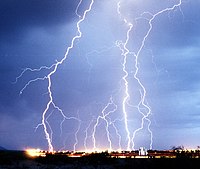
Atomic-scale modeling toward enabling models of surface nanostructure formation in plasma-facing materials
Sign Up to like & getrecommendations! Published in 2019 at "Current Opinion in Chemical Engineering"
DOI: 10.1016/j.coche.2019.03.001
Abstract: Designing plasma-facing components (PFCs) that can tolerate the extreme heat and particle flux exposure conditions inside a fusion reactor core is one of the major obstacles toward the practical realization of nuclear fusion. In this… read more here.
Keywords: formation; helium; surface; atomic scale ... See more keywords

Effect of ELMS and disruptions on FNSF plasma-facing components
Sign Up to like & getrecommendations! Published in 2017 at "Fusion Engineering and Design"
DOI: 10.1016/j.fusengdes.2017.07.022
Abstract: Abstract Previous work has addressed the thermomechanical and electromagnetic effects of ELMs and disruptions on plasma-facing components in conceptual, commercial fusion reactors. Given that the proposed Fusion Nuclear Science Facility (FNSF) will have different geometry… read more here.
Keywords: facing components; effect; plasma facing; first wall ... See more keywords

Emissivity measurement of tungsten plasma facing components of the WEST tokamak
Sign Up to like & getrecommendations! Published in 2019 at "Fusion Engineering and Design"
DOI: 10.1016/j.fusengdes.2019.111328
Abstract: Abstract Since tungsten (W) has been selected as material for the ITER divertor target the knowledge of the emissivity in the infrared (IR) wavelength range becomes mandatory. A dedicated setup has been developed to measure… read more here.
Keywords: emissivity; tungsten; emissivity measurement; plasma facing ... See more keywords

Inverse radiation problem with infrared images to monitor plasma-facing components temperature in metallic fusion devices
Sign Up to like & getrecommendations! Published in 2020 at "Fusion Engineering and Design"
DOI: 10.1016/j.fusengdes.2020.111867
Abstract: Abstract Infrared (IR) diagnostics are used to measure plasma-facing components (PFC) surface temperature in fusion devices. However, the interpretation of such images is complex in all-reflective environments because of unknown emissivity and multiple reflections issues.… read more here.
Keywords: fusion devices; fusion; method; temperature metallic ... See more keywords

Hydraulic assessment of an upgraded pipework arrangement for the DEMO divertor plasma facing components cooling circuit
Sign Up to like & getrecommendations! Published in 2021 at "Fusion Engineering and Design"
DOI: 10.1016/j.fusengdes.2021.112368
Abstract: Abstract In the context of the Work Package DIVertor (WPDIV) of the EUROfusion action, a research campaign has been carried out by University of Palermo in cooperation with ENEA to assess the thermal-hydraulic performances of… read more here.
Keywords: plasma facing; cooling circuit; circuit; demo divertor ... See more keywords

Thermal shock of tungsten carbide in plasma-facing conditions
Sign Up to like & getrecommendations! Published in 2019 at "Journal of Nuclear Materials"
DOI: 10.1016/j.jnucmat.2019.06.041
Abstract: Abstract Tungsten carbide (WC) has been found to have higher resistance to plasma-induced thermal-shock compared to rolled tungsten. The electron beam device JUDITH 1 was used to simulate likely thermal shock conditions induced by edge… read more here.
Keywords: carbide plasma; thermal shock; plasma facing; shock tungsten ... See more keywords

Tungsten fibre-reinforced composites for advanced plasma facing components
Sign Up to like & getrecommendations! Published in 2017 at "Nuclear materials and energy"
DOI: 10.1016/j.nme.2016.10.018
Abstract: The European Fusion Roadmap foresees water cooled plasma facing components in a first DEMO design in order to provide enough margin for the cooling capacity and to only moderately extrapolate the technology which was developed… read more here.
Keywords: cucrzr; facing components; tungsten fibre; plasma facing ... See more keywords

Compositions and chemical states on the co-deposition layer of lithiated tungsten of plasma-facing components of EAST
Sign Up to like & getrecommendations! Published in 2017 at "Nuclear materials and energy"
DOI: 10.1016/j.nme.2017.02.002
Abstract: Abstract Lithiation is beneficial to enhance plasma performance in EAST by reducing hydrogen and impurities recycling via lithium (Li) wall conditioning. High-Z materials like tungsten (W) have been selected as up–divertor in EAST tokamak. However,… read more here.
Keywords: states deposition; deposition layer; plasma facing; spectroscopy ... See more keywords

Recent progress on the R&D of W-ZrC alloys for plasma facing components in fusion devices
Sign Up to like & getrecommendations! Published in 2018 at "Nuclear materials and energy"
DOI: 10.1016/j.nme.2018.07.002
Abstract: Abstract Tungsten is considered as the most promising material for plasma facing components (PFCs) in the magnetic confinement fusion devices, due to its high melting temperature, high thermal conductivity, low swelling, low tritium retention and… read more here.
Keywords: zrc alloys; fusion devices; plasma facing; facing components ... See more keywords

Adhesion force of W dust on tokamak W plasma-facing surfaces: The importance of the impact velocity
Sign Up to like & getrecommendations! Published in 2019 at "Nuclear Materials and Energy"
DOI: 10.1016/j.nme.2019.02.001
Abstract: Abstract The adhesion of tungsten (W) dust particles on W tokamak plasma-facing surfaces is investigated. When spherical dust hits the tokamak walls, its shape is altered as a contact area is created by the adhesion… read more here.
Keywords: tokamak plasma; velocity; adhesion; force ... See more keywords

Tritium retention in W plasma-facing materials: Impact of the material structure and helium irradiation
Sign Up to like & getrecommendations! Published in 2019 at "Nuclear Materials and Energy"
DOI: 10.1016/j.nme.2019.03.005
Abstract: Plasma-facing materials for next generation fusion devices, like ITER and DEMO, will be submitted to intense fluxes of light elements, notably He and H isotopes (HI). Our study focuses on tritium (T) retention on a… read more here.
Keywords: retention; plasma facing; inventory; facing materials ... See more keywords